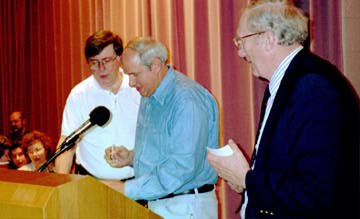 Published April 15, 1997
Published April 15, 1997

 Comet Hale-Bopp
Comet Hale-Bopp
1997 World (Earth) Tour

Autograph seekers line up for the signature of Hale-Bopp co-discoverer Thomas Bopp, center, after the amateur astronomer's speech at Youngstown State University April 14. At right is Dr. Warren Young, chairman of the YSU Department of Physics and Astronomy who, years aog, helped introduce the Youngstown-area native to the Machoning Valley Astronomical Society. (Kim Curry/Herald)
YOUNGSTOWN
Finding comet turns astronomer into a star
By Kim Curry
Herald Staff Writer
Thomas Bopp can thank his lucky stars, but more importantly his persistence, for being one of two men to first report a new comet on July 22, 1995.
Bopp, an amateur astronomer, and some friends were stargazing that night about 90 miles southwest of his Arizona home and focused on M-70, a globular star cluster in Sagittarius. During Bopp's turn at the telescope he saw a ``slight glow'' drift into sight.
``I tried to focus it and get individual stars but it wouldn't do that,'' the 1967 Chaney High School grad and former Youngstown State University student told a crowd of more than 400 at YSU Monday. Several star atlases were no help in identifying the object, which Bopp's friend Jim Stevens concluded to be a comet.
They watched it move against the background stars for almost an hour to be sure.
``Ninety percent are false alarms so I didn't want to be the fool,'' Bopp said, adding that nobody in the group had ever made a discovery.
After another 20 minutes of watching, Bopp reached for his cellular phone and asked information for the number of a Flagstaff astronomer but got his answering machine. He called the operator back to report his finding to the International Astronomical Union, but his phone decided he was out of range. [PAR] Frustration started setting in. Bopp jumped in his car and drove for 20 miles to a truck stop where he assumed he could call Western Union. ``They send thousands of telegrams every year, surely they have a list of common numbers,'' he theorized. ``Uh-uh. No address, no number, no help.''
Bopp drove home and rooted around for the IAU address. He called central Massachusetts and asked for the number of the Harvard Smithsonian Astrophysical Observatory, home of the IAU. However, the number turned out to be for the visitors center, which opened at 8 a.m. He called Western Union with the address and filed a report. It was 2:40 a.m. and Bopp went to bed. ``I was feeling rather dejected thinking somebody's probably reported it by now.''
In fact, professional astronomer Alan Hale of New Mexico was observing M-70 at the same time from another site in Arizona; he also spotted the comet.
At 8:25 the next morning, Bopp's wife, Charlotte, said someone from the ``Harvard Smithsonian something or other'' was on the phone. ``My feet didn't even hit the floor I was outside the bedroom so fast. I forgot all about the telephone in the bedroom.''
Dan Green, the man on the other end, asked if Bopp had reported a comet. Green said they would do some more checking but offered congratulations on finding a new one. ``When I hung up the phone I invented a new comet dance around the kitchen. My wife really thought I was crazy then.''
On July 24, Hale called Bopp. The men congratulated each other. Soon after, the comet was observed by amateurs and professionals alike. By July 26, there had been 57 observations worldwide _ enough to calculate a preliminary orbit. The orbit was refined Aug. 1 with 208 positive reports. ``People began speculating if this comet would amount to anything,'' he said.
Astronomers in New South Wales, Australia, sifted through photographs taken in 1993 and found evidence of Hale-Bopp. However, nobody would have recognized it at that time, Bopp said, because it was more than 1,000 times fainter. But the photo offered additional information about the orbit.
Scientists learned the comet had been here 4,200 years ago. Jupiter's gravity had modified its orbit, Bopp said. ``As the days and weeks passed, the comet began to brighten,'' he said.
Bopp said he was impressed by the caliber of photographs which captured the comet _ with its nucleus (never seen), fuzzy coma (the head which surrounds the nucleus), bluish ion tail and yellowish dust tail _ for Internet browsers.
Some of the spectacular slides he presented Monday (between speeches in Pittsburgh and the state of Indiana) showed Hale-Bopp both as a ghostly hand and fiery Phoenix in space and as a white streak next to a forest fire in Italy.
Estimates have put the size of the comet's nucleus at about 25 miles in diameter _ three times larger than Halley's Comet, Bopp said. The tail of a comet like Hale-Bopp can be many millions of kilometers long.
The headline-making comet was best seen here on April 1. Good views are expected again starting April 25 through mid-May. It can best be viewed about an hour after sunset in the west-northwest.
The last sightings with the naked eye are expected in the southern hemisphere next November.
Back to The Herald comet page

Back to TOP // Herald
Local news // Herald
Home page

Updated April 29, 1997
Questions/comments: herald@pgh.net
For info about advertising on our site or Web-page creation:
advertising@sharon-herald.com
Copyright ©1997 The Sharon Herald Co. All rights reserved.
Reproduction
or retransmission in any form is prohibited without our permission.

 Comet Hale-Bopp
Comet Hale-Bopp